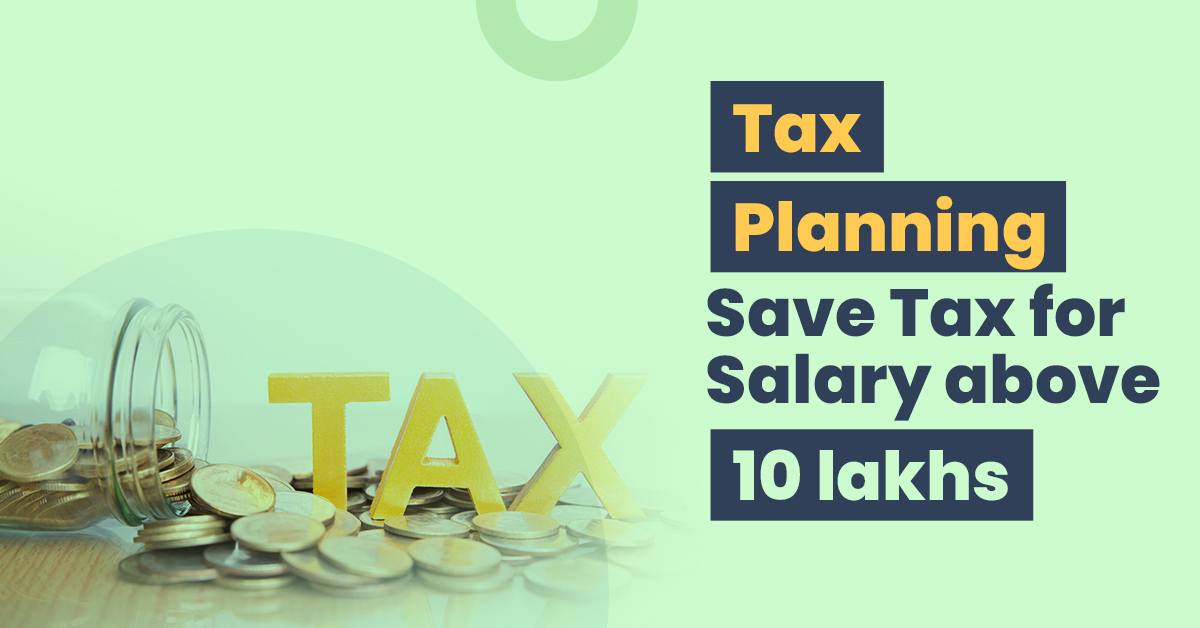How to Save Tax on Salary Above 10 Lakhs?


If you are a salaried individual earning a net salary of 10 lakhs per annum, you should first be conversant with your existing tax liability. Once you are aware of the same, you can determine how to save tax for salary above 10 lakhs by availing of the required deductions under the Income Tax Act. In this blog we will help you understand how to save income tax on your salary if it’s above 10 lakhs?
Figure out the tax bracket you are in.
The income tax rates for the fiscal year 2023-24 are levied under the new regime as well as the old one. Under the new regime, taxpayers have the option to pay income tax at lower rates on the condition that they give up certain permissible deductions and mandatory exemptions under the Income Tax Act.
Let’s take a look at the income tax slab rate under both regimes:
| Annual Income | New Tax Regime | Old Tax Regime |
| Rs. 0 – 2.5 lakhs | NIL | Nil |
| Rs. 2.5 lakhs – 3 lakhs | 5% (Tax rebate under section 87a is available) | 5% (tax rebate u/s 87a is available) |
| Rs. 3 lakhs – 5 lakhs | 5% (Tax rebate under section 87a is available) | 5% (tax rebate u/s 87a is available) |
| Rs. 5 lakh – 7.5 lakh | 10% | 20% |
| Rs. 7.5 lakh – 10 lakh | 15% | 20% |
| Rs. 10 lakh – 12.5 lakh | 20% | 30% |
| Rs. 12.5 lakh – 15 lakh | 25% | 30% |
| Above Rs 15 lakh | 30% | 30% |
Tax bracket for income above 10 lakhs
If you are earning an annual income of above 10 lakhs, you can fall under three tax slabs under the new regime. For the income bracket of Rs. 10 lakh per annum to 12.5 lakhs per annum, the income tax levied will be 20% of the net income. The next respective slab is Rs 12.5 lakhs to 15 lakhs per annum, where income tax levied will be 25%. Finally, if your income is above and over Rs. 15 lakhs per annum, the tax charged is 30%.
On the other hand, any income above Rs.10 lakhs is taxed at 30% under the old tax regime.
In the following sections, we will discuss how to save tax for salary above 10 lakhs.
Read More: Income Tax Slabs For FY 2022-23
How to Save Tax for Salary Above 10 Lakhs?
You can use the following methods to save on income tax even if your salary is more than Rs 10 lakh. Read on to know how –
Restructuring of Salary
You can ask your employer to structure your salary in such a way that the basic pay remains relatively low and the gross amount increases owing to the addition of allowances and other provisions. This way, your taxable income itself will be lower than otherwise.
Standard deduction offered by the Government
Government offers a standard tax deduction of Rs. 50,000 for salaried individuals. So if your total income is Rs 10 lakh from salary, the net taxable income gets reduced to (Rs. 10 lakh – Rs. 50,000) = Rs. 9.5 lakhs. Your salary automatically moves to the preceding slab of Rs. 7.5 lakhs to Rs. 10 lakhs per annum, which reduces your income tax (20% under the old regime). Please note that this deduction is not applicable in the new tax regime.
Investment options under section 80C
| Investment | Returns | Lock-in Period |
| 5-Year Bank Fixed Deposit | 6% to 7% | 5 years |
| Public Provident Fund (PPF) | 7% to 8% | 15 years |
| National Savings Certificate | 7% to 8% | 5 years |
| National Pension System (NPS) | 12% to 14% | Till Retirement |
| ELSS Funds | 15% to 18% | 3 years |
| Unit Linked Insurance Plan (ULIP) | Varies with Plan Chosen | 5 years |
| Sukanya Samriddhi Yojana (SSY) | 8.20% | N/A |
| Senior Citizen Saving Scheme (SCSS) | 7.40% | 5 years |
The above ax saving investments are available only under the old tax regime of the Income Tax Act. You can invest in tax-saving instruments under section 80C, and reduce your taxable income by up to Rs. 1,50,000 annually. The most popular tax-saving investments include Employee Provident Fund, tax-saver FDs, Public Provident Fund, ELSS Funds, etc.
Also Read: TDS On Salary – Calculation, Deductions, Limit & more
Deduction under 80CCD (1B) upto Rs 50000 for NPS investment
Investing in the NPS or the National Pension Scheme will enable you to reduce your taxable income by Rs. 50,000. This provision comes under the subsection 80CCD (1B) of the income tax act. After deducting your 80C investments and NPS investments, your net taxable income will become Rs. 7.5 lakhs.
Deduction under 80 EE upto Rs 2 lakhs for home loan interest
If you have taken a home loan, then you can get a tax deduction of up to Rs. 2 lakhs on annual interest payments. Therefore, your net taxable income will now become Rs. 7.7 lakhs – Rs. 2 lakhs which equals Rs. 5.5 lakhs.
Deduction under section 10 (13A) for House Rent Allowance
House Rent Allowance (HRA) is a part of the salary employers provide to employees to compensate for their expenses incurred against rent accommodation. For metro cities, 50% of the basic salary is eligible for tax deductions under HRA. In contrast, in non-metro cities, the same tends to be 40%.
Also Read: TDS On Salary – Calculation, Deductions, Limit & more
Deduction under section 80D for Health insurance premium
Under section 80D, you can claim tax deductions against insurance premiums for yourself, spouse, children, parents, etc. This can help you earn deductions of Rs.25,000. f your parents are above 60 years of age, you can claim a maximum deduction of Rs. 50,000. Thus, the net taxable income becomes Rs. 4.75 lakhs. After deducting this amount, the net taxable income now becomes Rs. 5.25 lakhs.
Income:
Total Income from Salary = Rs. 10,00,000 (A)
Deductions:
Standard deductions = Rs. 50,000 (B)
Tax benefits under section 80C = Rs. 1,50,000 (C)
Deductions under NPS = Rs. 50,000 (D)
Deductions under Home Loan = Rs. 2,00,000 (E)
Health insurance premium = Rs. 50,000 (F)
Health Insurance Premium for senior citizen parents = Rs. 50,000 (G)
Net Taxable Income = A- (B+C+D+E+F+G)
Rs.4,75,000
*Please note that the above example has been kept fairly simple for understanding purpose.*
Also Read: Guide on How to Calculate Income Tax on Salary: Learn with Example
Leave Travel Allowance (LTA)
Leave Travel Allowance (LTA) is the amount employers provide to their employees to make up for their expenses incurred in travelling while on leave.
Special Allowance
It is the amount employers pay to employees for various reasons but mainly to compensate for expenses incurred while performing work duty.
Closing Thoughts
It may seem that earning an annual income of more than Rs. 10 lakhs would come up with major tax liability. However, the fact is if you can plan your finances well and invest your money in the right places, the tax liability could be reduced to as low as possible. If you want to know how to save tax for salary above 10 lakhs, you just have to take advantage of the available financial resources and use them to reduce your tax slab and thus the income tax rate.
FAQs
Is everyone required to file their income tax return?
An individual who earns less than Rs. 2,50,000 per annum does not have to file an income tax return as his tax liability is zero. Above Rs. 2.5 lakhs per annum, there are several slabs of income that have been segregated. In accordance with each of those income slabs, a person must file the respective income tax amount.
Is it mandatory that I select the new tax regime while paying taxes under the AY 2021-22?
No, it is not a mandatory process to select the new tax regime or follow it rigorously while paying taxes under the AY 2021-22. The Finance Ministry had made it optional and the onus is upon the taxpayers to choose between the old and new.
Which tax regime is better for income tax?
It is a very tricky question as the old tax regime had a higher percentage of tax payable for a particular range of taxable salaries, whereas the newer tax regime has more breakdowns in terms of ranges of taxable salaries. It is entirely upon the individual who is paying the tax and the income slab that will determine his/her tax rate.
What income slabs are tax-free?
If your yearly income is between 0 to Rs. 2.5 lakhs per annum, then your income is completely tax-free. This is a common regulation under the old tax regime as well as the new tax regime that income of up to Rs. 2.5 lakhs per annum has been made completely tax-free. Further, under section 87A if your taxable income is up to Rs 5,00,000, you will get a tax rebate of Rs 12,500 or equal to the amount of tax payable.






